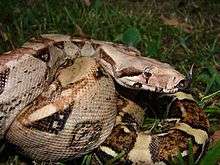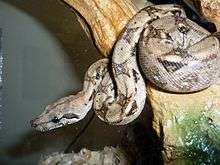Boa imperator
| Boa imperator | |
|---|---|
 | |
| Scientific classification | |
| Kingdom: | Animalia |
| Phylum: | Chordata |
| Class: | Reptilia |
| Order: | Squamata |
| Suborder: | Serpentes |
| Family: | Boidae |
| Genus: | Boa |
| Species: | B. imperator |
| Binomial name | |
| Boa imperator Daudin, 1803 | |
| Synonyms | |
Boa Imperator is a nonvenomous boa (genus) species[2] found in Mexico, Central America, and South America east of the Andes Mountains (primarily Colombia), commonly called Northern Boa and Common Boa.
Description
B. imperator is wide-ranging, with animals living in both Central America and northern parts of South America.[3] As a result, the appearance of this snake varies greatly depending on the specific locality.
One population is found on the Cayos Cochinos (Hog Islands) off the north shore of Honduras. These are naturally hypomelanistic, which means that they have reduced melanin, thus are more lightly colored, although they retain the distinctive darker tail that is characteristic of most members of this species. The color of the tail may vary from salmon pink to orange.

Another well known population of B. imperator is the population from Nicaragua. While not as small as the dwarf insular island populations, adults are still smaller than the larger B. c. constrictor. The size of a mature female Nicaraguan boa is 1.1 m and 1.9 kg, while the larger female B. c. constrictor is not mature until she reaches 1.6 m and 4.5 kg.[4] Nicaraguan individuals typically have a compact saddle pattern on their backs that is often circular in shape.[5] These boas have a reputation for being "nippy", with some individuals being quick to bite in self-defense.
Mainland specimens from Colombia can be among the larger boas, but this subspecies also includes a number of dwarf insular populations, such as those from various Caribbean islands and the Sonoran Desert of Mexico. These populations represent the smallest of the species.
Some generalizations can be made despite the wide range in which B. imperator survives. As one of the smaller Boa species,[6] they average between 1.3 and 2.5 m in length when fully grown, but have been known to reach 3.7 m.[7] They usually weigh around 6 kg (13 lb), although females are significantly larger than males. Lifespan in the wild is around 20–30 years, but 40 can be exceeded in captivity.[6] Although B. imperator exhibits almost identical patterns to the recognized species of B. constrictor, this species often has a darker tail, usually dark brown or very dark red. They are, however, usually just as colorful as their counterparts, and like the larger boas can be bred into a variety of different colors given the right conditions to breed.
Geographic range
The type locality given is "l'Amerique meridionale, principalement au Mexique" (Central America, principally Mexico).[1]
Captivity
This snake species is becoming popular in the exotic pet trade, due in part to the vast amounts of color and pattern morphs that breeders are creating, as well as their manageable size in comparison to B. constrictor. Typically these snakes are very well tempered and easy to breed. Although not as thick-bodied as ball pythons, they do, on average, get longer and have a stronger feeding response in comparison to ball pythons.
See also
- Boinae by common name
- Boinae by taxonomic synonyms
- List of boine species and subspecies
References
- 1 2 McDiarmid RW, Campbell JA, Touré T. 1999. Snake Species of the World: A Taxonomic and Geographic Reference, vol. 1. Herpetologists' League. 511 pp. ISBN 1-893777-00-6 (series). ISBN 1-893777-01-4 (volume).
- ↑ "Boa imperator". Integrated Taxonomic Information System. Retrieved 7 July 2008.
- ↑ "Archived copy". Archived from the original on 2011-07-15. Retrieved 2011-03-03.
- ↑ "Boa Care". Rio Bravo Reptiles. Retrieved 2013-04-18.
- ↑ "theboas.com". theboas.com. Archived from the original on 2013-02-04. Retrieved 2013-04-18.
- 1 2 Cotswold Wildlife Park and Gardens Archived October 23, 2007, at the Wayback Machine.
- ↑ "Common Boa Constrictor - Boa constrictor imperator". Exotic-pets.co.uk. Retrieved 2013-04-18.
External links
- Boa imperator at the Reptarium.cz Reptile Database. Accessed 7 July 2018.